Bowen Baker
Monitoring Monitorability
Dec 20, 2025Abstract:Observability into the decision making of modern AI systems may be required to safely deploy increasingly capable agents. Monitoring the chain-of-thought (CoT) of today's reasoning models has proven effective for detecting misbehavior. However, this "monitorability" may be fragile under different training procedures, data sources, or even continued system scaling. To measure and track monitorability, we propose three evaluation archetypes (intervention, process, and outcome-property) and a new monitorability metric, and introduce a broad evaluation suite. We demonstrate that these evaluations can catch simple model organisms trained to have obfuscated CoTs, and that CoT monitoring is more effective than action-only monitoring in practical settings. We compare the monitorability of various frontier models and find that most models are fairly, but not perfectly, monitorable. We also evaluate how monitorability scales with inference-time compute, reinforcement learning optimization, and pre-training model size. We find that longer CoTs are generally more monitorable and that RL optimization does not materially decrease monitorability even at the current frontier scale. Notably, we find that for a model at a low reasoning effort, we could instead deploy a smaller model at a higher reasoning effort (thereby matching capabilities) and obtain a higher monitorability, albeit at a higher overall inference compute cost. We further investigate agent-monitor scaling trends and find that scaling a weak monitor's test-time compute when monitoring a strong agent increases monitorability. Giving the weak monitor access to CoT not only improves monitorability, but it steepens the monitor's test-time compute to monitorability scaling trend. Finally, we show we can improve monitorability by asking models follow-up questions and giving their follow-up CoT to the monitor.
Weight-sparse transformers have interpretable circuits
Nov 17, 2025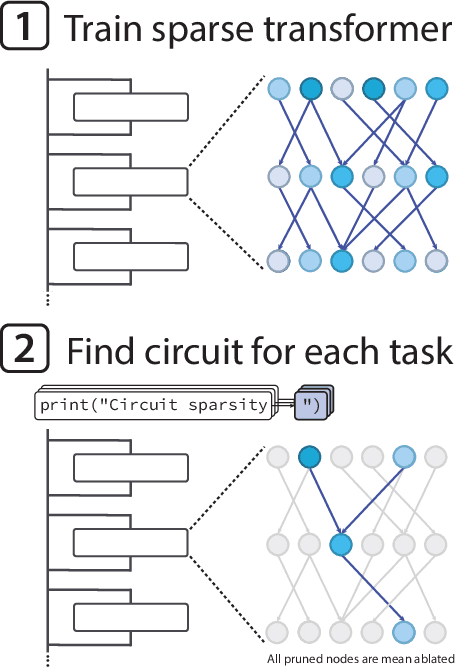
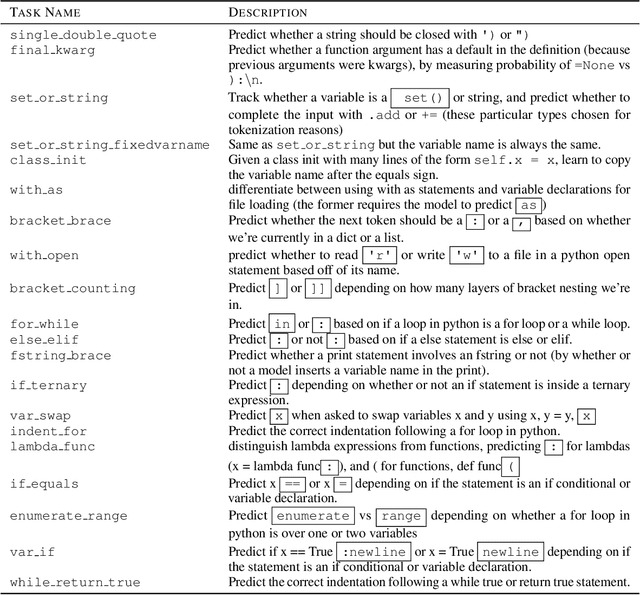
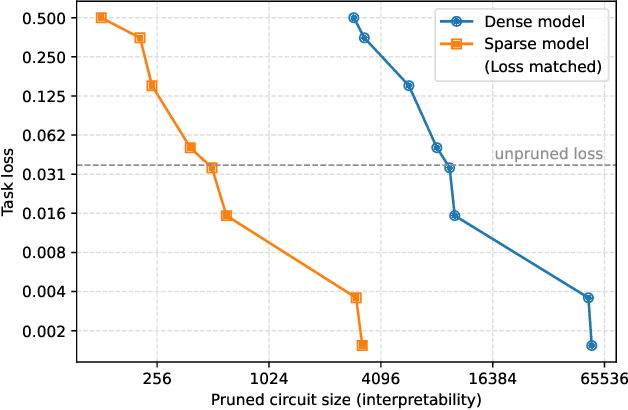
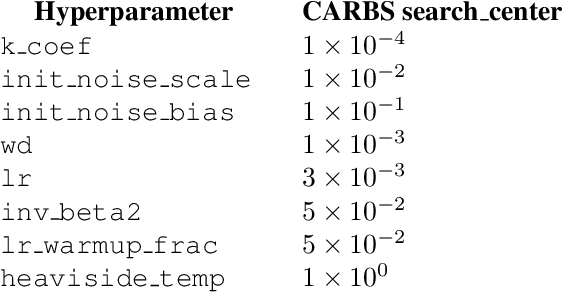
Abstract:Finding human-understandable circuits in language models is a central goal of the field of mechanistic interpretability. We train models to have more understandable circuits by constraining most of their weights to be zeros, so that each neuron only has a few connections. To recover fine-grained circuits underlying each of several hand-crafted tasks, we prune the models to isolate the part responsible for the task. These circuits often contain neurons and residual channels that correspond to natural concepts, with a small number of straightforwardly interpretable connections between them. We study how these models scale and find that making weights sparser trades off capability for interpretability, and scaling model size improves the capability-interpretability frontier. However, scaling sparse models beyond tens of millions of nonzero parameters while preserving interpretability remains a challenge. In addition to training weight-sparse models de novo, we show preliminary results suggesting our method can also be adapted to explain existing dense models. Our work produces circuits that achieve an unprecedented level of human understandability and validates them with considerable rigor.
Chain of Thought Monitorability: A New and Fragile Opportunity for AI Safety
Jul 15, 2025
Abstract:AI systems that "think" in human language offer a unique opportunity for AI safety: we can monitor their chains of thought (CoT) for the intent to misbehave. Like all other known AI oversight methods, CoT monitoring is imperfect and allows some misbehavior to go unnoticed. Nevertheless, it shows promise and we recommend further research into CoT monitorability and investment in CoT monitoring alongside existing safety methods. Because CoT monitorability may be fragile, we recommend that frontier model developers consider the impact of development decisions on CoT monitorability.
Monitoring Reasoning Models for Misbehavior and the Risks of Promoting Obfuscation
Mar 14, 2025Abstract:Mitigating reward hacking--where AI systems misbehave due to flaws or misspecifications in their learning objectives--remains a key challenge in constructing capable and aligned models. We show that we can monitor a frontier reasoning model, such as OpenAI o3-mini, for reward hacking in agentic coding environments by using another LLM that observes the model's chain-of-thought (CoT) reasoning. CoT monitoring can be far more effective than monitoring agent actions and outputs alone, and we further found that a LLM weaker than o3-mini, namely GPT-4o, can effectively monitor a stronger model. Because CoT monitors can be effective at detecting exploits, it is natural to ask whether those exploits can be suppressed by incorporating a CoT monitor directly into the agent's training objective. While we show that integrating CoT monitors into the reinforcement learning reward can indeed produce more capable and more aligned agents in the low optimization regime, we find that with too much optimization, agents learn obfuscated reward hacking, hiding their intent within the CoT while still exhibiting a significant rate of reward hacking. Because it is difficult to tell when CoTs have become obfuscated, it may be necessary to pay a monitorability tax by not applying strong optimization pressures directly to the chain-of-thought, ensuring that CoTs remain monitorable and useful for detecting misaligned behavior.
OpenAI o1 System Card
Dec 21, 2024



Abstract:The o1 model series is trained with large-scale reinforcement learning to reason using chain of thought. These advanced reasoning capabilities provide new avenues for improving the safety and robustness of our models. In particular, our models can reason about our safety policies in context when responding to potentially unsafe prompts, through deliberative alignment. This leads to state-of-the-art performance on certain benchmarks for risks such as generating illicit advice, choosing stereotyped responses, and succumbing to known jailbreaks. Training models to incorporate a chain of thought before answering has the potential to unlock substantial benefits, while also increasing potential risks that stem from heightened intelligence. Our results underscore the need for building robust alignment methods, extensively stress-testing their efficacy, and maintaining meticulous risk management protocols. This report outlines the safety work carried out for the OpenAI o1 and OpenAI o1-mini models, including safety evaluations, external red teaming, and Preparedness Framework evaluations.
Weak-to-Strong Generalization: Eliciting Strong Capabilities With Weak Supervision
Dec 14, 2023



Abstract:Widely used alignment techniques, such as reinforcement learning from human feedback (RLHF), rely on the ability of humans to supervise model behavior - for example, to evaluate whether a model faithfully followed instructions or generated safe outputs. However, future superhuman models will behave in complex ways too difficult for humans to reliably evaluate; humans will only be able to weakly supervise superhuman models. We study an analogy to this problem: can weak model supervision elicit the full capabilities of a much stronger model? We test this using a range of pretrained language models in the GPT-4 family on natural language processing (NLP), chess, and reward modeling tasks. We find that when we naively finetune strong pretrained models on labels generated by a weak model, they consistently perform better than their weak supervisors, a phenomenon we call weak-to-strong generalization. However, we are still far from recovering the full capabilities of strong models with naive finetuning alone, suggesting that techniques like RLHF may scale poorly to superhuman models without further work. We find that simple methods can often significantly improve weak-to-strong generalization: for example, when finetuning GPT-4 with a GPT-2-level supervisor and an auxiliary confidence loss, we can recover close to GPT-3.5-level performance on NLP tasks. Our results suggest that it is feasible to make empirical progress today on a fundamental challenge of aligning superhuman models.
Let's Verify Step by Step
May 31, 2023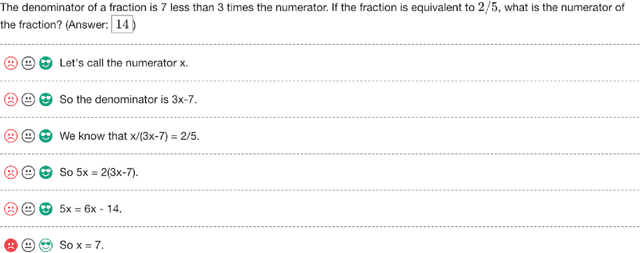

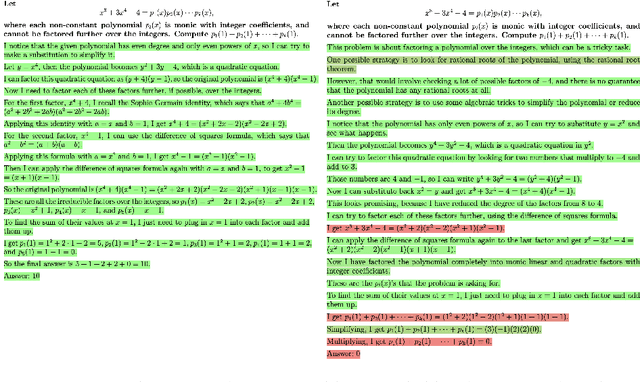

Abstract:In recent years, large language models have greatly improved in their ability to perform complex multi-step reasoning. However, even state-of-the-art models still regularly produce logical mistakes. To train more reliable models, we can turn either to outcome supervision, which provides feedback for a final result, or process supervision, which provides feedback for each intermediate reasoning step. Given the importance of training reliable models, and given the high cost of human feedback, it is important to carefully compare the both methods. Recent work has already begun this comparison, but many questions still remain. We conduct our own investigation, finding that process supervision significantly outperforms outcome supervision for training models to solve problems from the challenging MATH dataset. Our process-supervised model solves 78% of problems from a representative subset of the MATH test set. Additionally, we show that active learning significantly improves the efficacy of process supervision. To support related research, we also release PRM800K, the complete dataset of 800,000 step-level human feedback labels used to train our best reward model.
Video PreTraining : Learning to Act by Watching Unlabeled Online Videos
Jun 23, 2022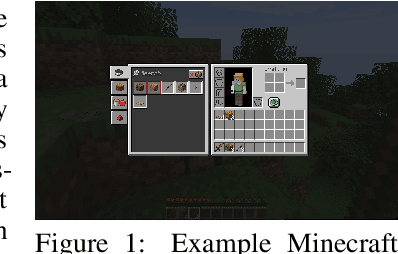
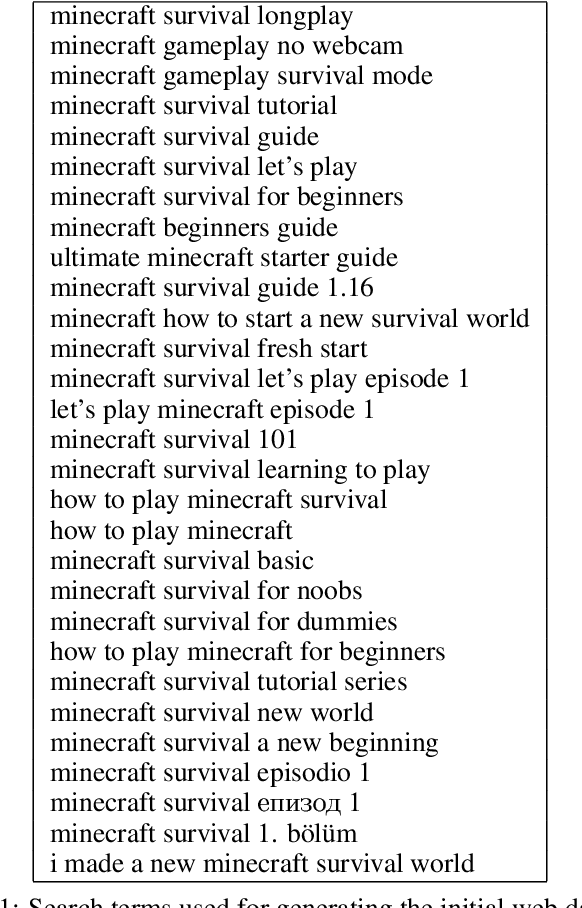

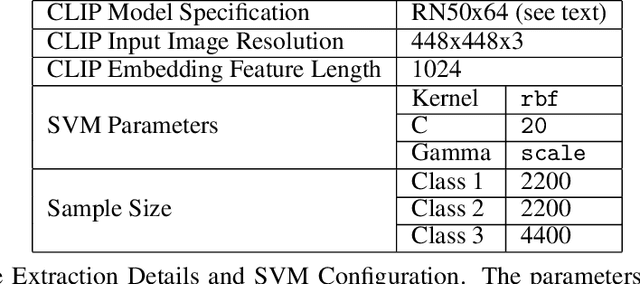
Abstract:Pretraining on noisy, internet-scale datasets has been heavily studied as a technique for training models with broad, general capabilities for text, images, and other modalities. However, for many sequential decision domains such as robotics, video games, and computer use, publicly available data does not contain the labels required to train behavioral priors in the same way. We extend the internet-scale pretraining paradigm to sequential decision domains through semi-supervised imitation learning wherein agents learn to act by watching online unlabeled videos. Specifically, we show that with a small amount of labeled data we can train an inverse dynamics model accurate enough to label a huge unlabeled source of online data -- here, online videos of people playing Minecraft -- from which we can then train a general behavioral prior. Despite using the native human interface (mouse and keyboard at 20Hz), we show that this behavioral prior has nontrivial zero-shot capabilities and that it can be fine-tuned, with both imitation learning and reinforcement learning, to hard-exploration tasks that are impossible to learn from scratch via reinforcement learning. For many tasks our models exhibit human-level performance, and we are the first to report computer agents that can craft diamond tools, which can take proficient humans upwards of 20 minutes (24,000 environment actions) of gameplay to accomplish.
Multi-task curriculum learning in a complex, visual, hard-exploration domain: Minecraft
Jun 28, 2021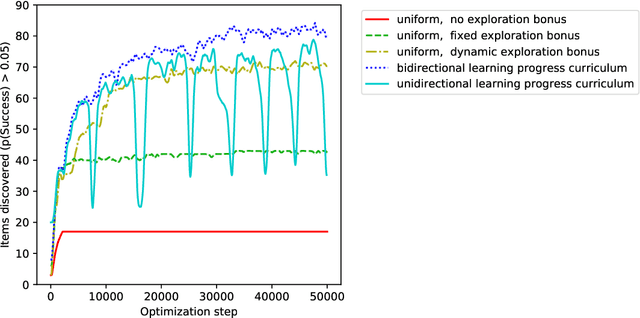
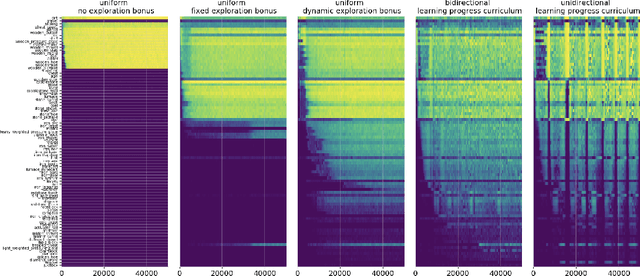
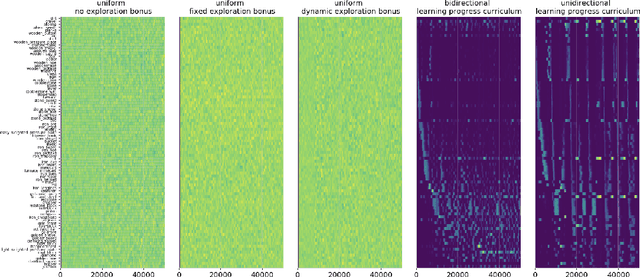
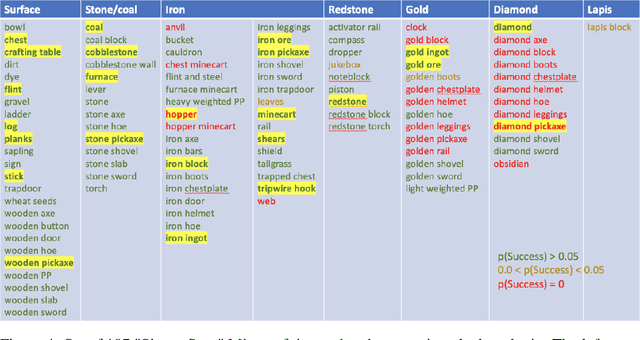
Abstract:An important challenge in reinforcement learning is training agents that can solve a wide variety of tasks. If tasks depend on each other (e.g. needing to learn to walk before learning to run), curriculum learning can speed up learning by focusing on the next best task to learn. We explore curriculum learning in a complex, visual domain with many hard exploration challenges: Minecraft. We find that learning progress (defined as a change in success probability of a task) is a reliable measure of learnability for automatically constructing an effective curriculum. We introduce a learning-progress based curriculum and test it on a complex reinforcement learning problem (called "Simon Says") where an agent is instructed to obtain a desired goal item. Many of the required skills depend on each other. Experiments demonstrate that: (1) a within-episode exploration bonus for obtaining new items improves performance, (2) dynamically adjusting this bonus across training such that it only applies to items the agent cannot reliably obtain yet further increases performance, (3) the learning-progress based curriculum elegantly follows the learning curve of the agent, and (4) when the learning-progress based curriculum is combined with the dynamic exploration bonus it learns much more efficiently and obtains far higher performance than uniform baselines. These results suggest that combining intra-episode and across-training exploration bonuses with learning progress creates a promising method for automated curriculum generation, which may substantially increase our ability to train more capable, generally intelligent agents.
Emergent Reciprocity and Team Formation from Randomized Uncertain Social Preferences
Nov 10, 2020
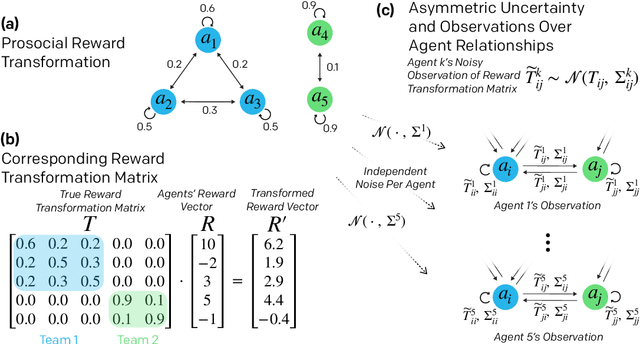


Abstract:Multi-agent reinforcement learning (MARL) has shown recent success in increasingly complex fixed-team zero-sum environments. However, the real world is not zero-sum nor does it have fixed teams; humans face numerous social dilemmas and must learn when to cooperate and when to compete. To successfully deploy agents into the human world, it may be important that they be able to understand and help in our conflicts. Unfortunately, selfish MARL agents typically fail when faced with social dilemmas. In this work, we show evidence of emergent direct reciprocity, indirect reciprocity and reputation, and team formation when training agents with randomized uncertain social preferences (RUSP), a novel environment augmentation that expands the distribution of environments agents play in. RUSP is generic and scalable; it can be applied to any multi-agent environment without changing the original underlying game dynamics or objectives. In particular, we show that with RUSP these behaviors can emerge and lead to higher social welfare equilibria in both classic abstract social dilemmas like Iterated Prisoner's Dilemma as well in more complex intertemporal environments.
 Add to Chrome
Add to Chrome Add to Firefox
Add to Firefox Add to Edge
Add to Edge